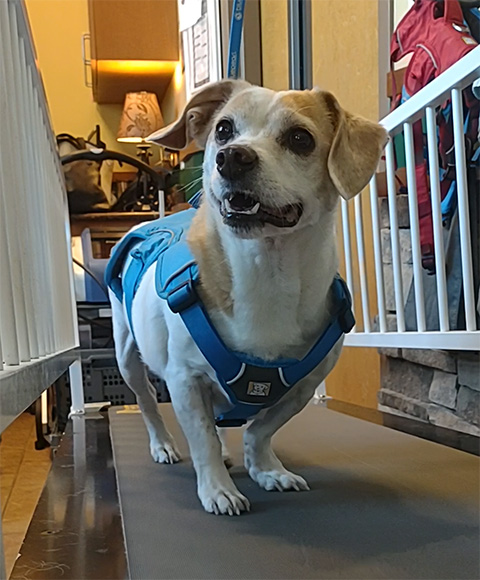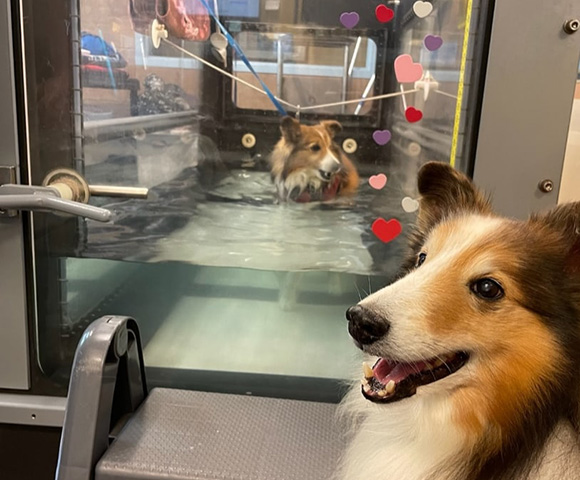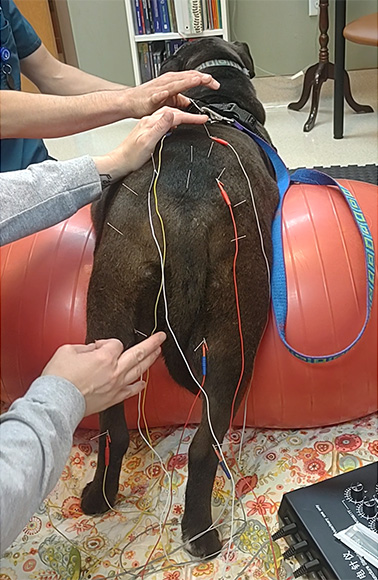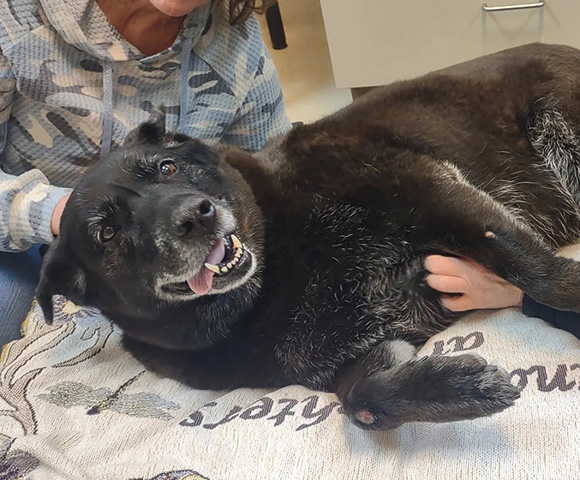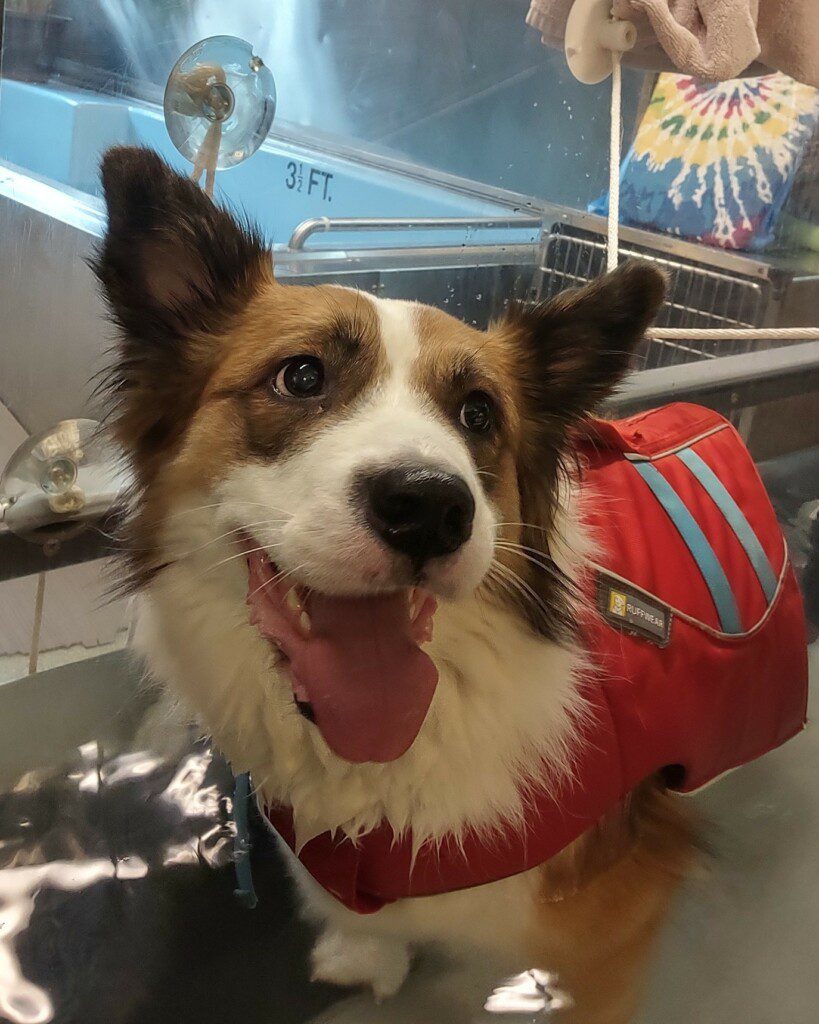Rehabilitation & pain management for pets.
Not all pain is created equal. As in humans, animals experience different types of pain that can cause distress, interfere with daily activity, and decrease quality of life. In veterinary pain management, there are many diverse methods used to alleviate pain, which parallels cutting-edge pain management modalities used in human medicine.
Our rehabilitation & pain management services.
Acupuncture
Acupuncture is a technique that was developed in China thousands of years ago to regulate "Qi" (life force) in the body and alleviate disease, including chronic pain, and improve nerve regeneration and preservation. Today, acupuncture is used for chronic and acute pain in dogs in conjunction with other pain modalities like medications, supplements and herbals.
In general, acupuncture is most beneficial for functional problems such as those that involve paralysis, noninfectious inflammation and pain. Regular acupuncture treatments can restore mobility for older pets, improve minor injuries as they occur and be administered preventatively to keep muscles and tendons resistant to injury.
The following are some of the conditions that can be improved through veterinary acupuncture:
- The muscular and skeletal systems: back pain, muscle soreness, disc problems, arthritis and degenerative joint disease
- Neurological disorders: chronic disc disease, radial nerve or facial paralysis and seizure
- Gastrointestinal disorders: diarrhea, constipation, vomiting and poor appetite
- Chemotherapy: nausea, vomiting, diarrhea, fatigue and inflammation
- Skin conditions: inflammation and skin problems such as allergic dermatitis and lick granulomas
- Other chronic conditions: asthma, geriatric weakness, immune system disorders and more
We provide safe, comforting acupuncture treatments for patients with chronic pain as well as several other chronic conditions. Our acupuncturists will consult with your pet’s primary care veterinarian for the best results and the fastest healing.
A typical treatment plan calls for one acupuncture session a week for 4-6 weeks, and then every other week for about a month. After the initial phase, most patients will have a session every 2-4 weeks, depending on their body’s response.
Chiropractic
Chiropractic medicine operates under the principle that “a body in motion stays in motion.” One of its main premises is that by optimizing motion, the health of the brain and spinal cord is maintained and improved. This is important because the central nervous system controls all bodily functions.
Chiropractic medicine encourages the body to use its innate healing abilities. Chiropractic care can be used for animals affected by decreased mobility or pain and as a preventative measure. As in humans, chiropractic medicine can be used as a standalone modality or in combination with other pain management techniques.
Cold Laser Therapy
Also known as low level laser, cold laser therapy reduces inflammation and treats hard-to-heal wounds or dermatological issues. The laser emits light (energy) at variable wavelengths, which promotes nutrient and oxygen delivery to diseased joints and tissues. In addition, the light waves stimulate mitochondria (“cellular powerhouse”) in diseased tissues. This promotes natural healing processes and reduces inflammation, thereby decreasing pain.
Ketamine Treatments
Ketamine constant rate infusions (CRI) require a pet to be in the hospital for about eight hours. During this time, an IV catheter delivers low doses of pain medication directly into the vein. The medications used will help “reset” pain receptors in the spinal cord.
This method is commonly used in human medicine for highly resistant forms of chronic pain.
Heated Indoor Training and Exercise Pool
The buoyancy of water allows pets to exercise and work their muscles in a low-impact manner. This is an excellent option for dogs or cats who are recovering from surgery or an injury, or who has limited range of motion due to a condition like obesity.
Underwater Treadmill
A form of hydrotherapy, underwater treadmills rely on the buoyancy of water to alleviate force on a pet’s body, allowing them to move and exercise with reduced discomfort. This enables a patient to build up muscle tone and strengthen limbs even if they have an injury or are healing after a procedure. Underwater treadmills are also helpful for overweight or obese pets who have difficulty moving but need to exercise to reach a healthy body weight.
Physical Rehabilitation/Physiotherapy
A cornerstone of most rehabilitation and pain management services includes some form of exercise program. Physical rehabilitation provides many benefits for most dogs that suffer from an orthopedic or neurologic impairment, including:
- Improved balance
- Cardiac conditioning
- Muscle building and strengthening
- Improved range of motion
- Pain management
This is also a fun and mentally stimulating form of treatment that most dogs enjoy.
In general, physical rehabilitation provides a dog with a sense of increased confidence, willingness and conditioning to perform daily activities more easily. While some exercises require specialized equipment and technicians specifically trained in rehabilitation, we can develop an at-home program for you and your pet to do together.
Joint Injections
Depending on the cause of decreased mobility or lameness, joint injections may be used to help manage pain and improve mobility. There are a variety of medications that can be used in joint injections including platelet-rich plasma (PRP), hyaluronic acid, local anesthetic and, occasionally, steroids.
In most cases, a pet does not need to be under anesthesia for injections, just under short-term, fast-acting sedation.
Platelet Rich Plasma
Also known as PRP, platelet rich plasma injections are a form of regenerative medicine that uses a pet’s biological material to treat or prevent conditions like osteoarthritis. A small amount of blood is drawn from the patient, then filtered into a smaller portion containing a concentrated amount of platelets. These platelets contain large quantities of bioactive proteins such as growth factors, cytokines and interleukins that promote tissue healing, decrease inflammation and improve mobility.
Once the blood is drawn and processed, the distilled portion is injected into a diseased joint or tissue. Patients are heavily sedated for the procedure, including the blood draw, blood processing and joint injection, and will need to be at the hospital all day for monitoring.
Usually, a series of three injections is recommended, but every patient is different; some will require all three injections to see results while some only need one.
Steroid Epidural
Steroid epidurals can treat lumbosacral pain and instability, among other conditions. Injecting a small volume of steroid into the epidural space (around the spinal cord) can decrease inflammation and swelling, thereby decreasing pain at the spinal cord level. This is a technique very similar to that used in human medicine.
Steroid injections can be a very effective method of pain management, however, they are not without risk. Epidurals require heavy sedation or anesthesia, which is generally safe, but there is always some risk when sedating or anesthetizing a pet.
Epidurals require a large needle to be placed in a very small space near the spinal cord, which can, in rare situations, cause an extreme drop in heart rate and, in very rare cases, death or permanent spinal cord damage. Again, these are very rare complications, and our experienced team is happy to discuss your concerns about your pet’s well-being.
It is recommended to have three epidurals performed about a month apart, and then as needed after that.
Therapeutic Ultrasound
Therapeutic ultrasound for the treatment of muscle contracture and tissue healing, and is a particularly effective treatment option for soft tissue conditions such as:
- Tendonitis/bursitis
- Joint contraction
- Restricted range of motion
- Pain
- Trigger points
- Calcified soft tissue
- Wound healing
Therapeutic ultrasound transmits sound waves through the skin to heat the affected area. This deep warming (as the tissues absorb sound waves) leads to a mild, local pro-inflammatory response, which stimulates mast cells, thrombocytes, neutrophils and macrophages to accelerate healing. As the warming wears off, the remodeling phase occurs and helps prevent scar tissue formation.
Tui-Na Massage
Tui-na is a traditional Chinese therapy used to manually address pain in the body, most commonly acute and chronic musculoskeletal conditions. It can best be described in modern terms as a combination of standard massage, acupressure and chiropractic therapy.
This therapy pairs well with other modalities like acupuncture for a holistic treatment program to promote circulation, healing and overall vitality.
Shockwave Therapy
Shockwave therapy uses acoustic waves (sound waves) to mechanically stimulate deep tissue in a focused and precise manner. Shockwave is typically used for pain relief from orthopedic injuries; however, there is an evolving body of data demonstrating the effectiveness of shock wave therapy for soft tissue injuries such as tendons, ligaments, and muscle diseases and conditions.
Shockwave works by stimulating the cellular mechanisms for tissue repair and remodeling. This results in restored function and decreased pain levels. A typical treatment is once a week for 3-6 treatments and is most effective when used with other forms of rehabilitation such as exercises, passive range of motion (PROM) and hydrotherapy.
Electromagnetic Therapy
Targeted pulsed electromagnetic field (tPEMF) therapy helps reset pain channels in nerves and elicit neurotransmitters that help in the recovery process. This therapy is delivered using a device called an Assisi loop, which is applied around a certain area of the body (e.g., hips or knees) to help stop the transmission of pain, improve blood flow and decrease inflammation.
Typically, Assisi loops are not used exclusively on their own but in conjunction with other modalities. They can be used daily with no known adverse side effects.
Meet our rehabilitation & pain management team.
Dr. Ashley Barton attended veterinary school at Kansas State University and continued her education to become board-certified in Veterinary Anesthesia and Analgesia by completing a residency at Cornell University. To extend her skills, she studied at the Chi Institute to become certified in veterinary acupuncture and Tui-Na. Dr. Barton also holds accreditation from The International Veterinary Chiropractic Association (IVCA). She received her Certified Canine Rehabilitation Certification (CCRP) from the University of Tennessee.
Dr. Barton is accompanied by a phenomenal team of veterinary technicians and assistants who have received extensive education and training to deliver the highest level of care for pets.
Our closely knit team is available five days a week for client questions, training and appointments.
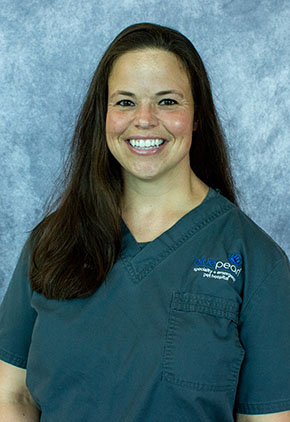
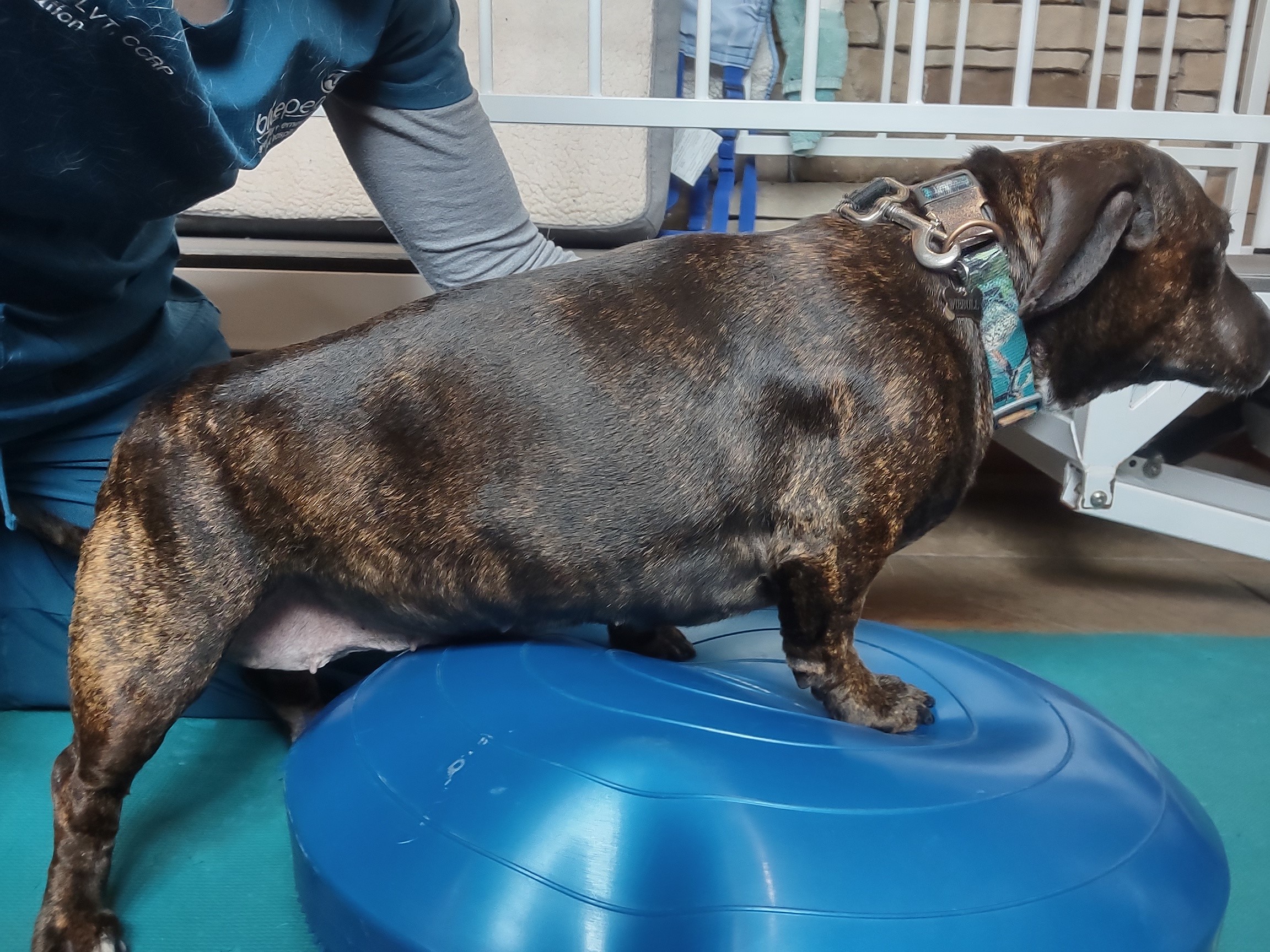
Success story: Wiebull’s rehabilitation and recovery.
Our pain management team has seen countless successes over the years both big and small, but our most recent miracle is Wiebull. Wiebull’s owner brought the female mixed-breed dog in for rehabilitation following a spinal disc herniation. When surgical intervention wasn’t possible, Wiebull was referred to BluePearl to heal and hopefully regain the ability to walk on her own.
After a thorough exam and devising a six-week exercise plan, Wiebull went right to work. She was prescribed a combination of acupuncture, cold laser therapy, underwater treadmill therapy and at-home exercises.
Caring for a pet that can't walk can be challenging, but Wiebull's owner's tireless efforts were rewarded with a nearly flawless recovery! Wiebull regained not only her comfort, but her ability to walk and enjoy almost all of her normal activities. Watching Wiebull trotting happily into the hospital to see Dr. Barton for a follow-up filled us with pride and joy.
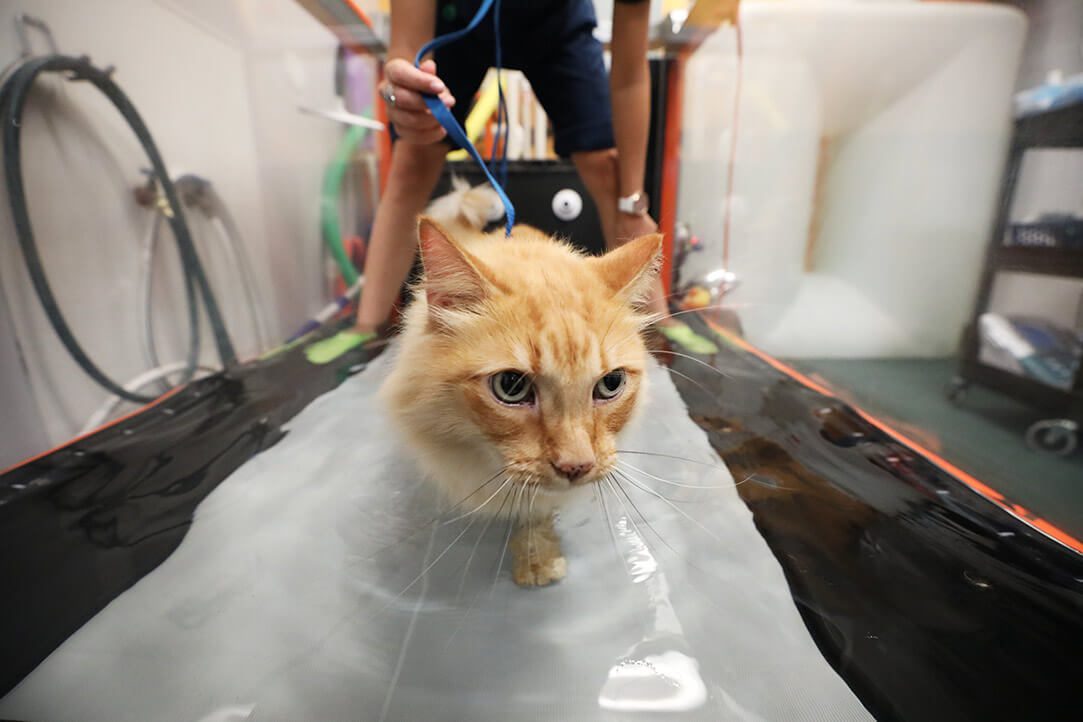
BluePearl Columbia on Instagram.
For more patient success stories and exclusive behind-the-scenes videos and pictures, check out our hospital's Instagram.
